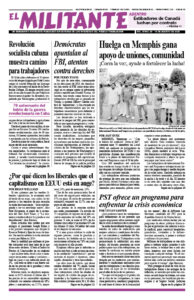SEPT-ILES, Quebec — As of July 18, the New York Times reported that wildfires in Canada have destroyed 25 million acres so far this year — close to double the last few years.
Hardest hit have been the First Nations, whose reserves are located in the heavily forested northern regions. They have been discriminated against and abused by the government for decades.
As of July 28 over 1,000 fires were burning across Canada, 600 out of control. When forest fires on Quebec’s North Shore were at their height in early June, Mani-Utenam, an Innu reserve of some 1,500 residents nine miles east of here, was ordered to evacuate.
“We got on buses after being notified about 5 p.m. that we needed to leave in the next two hours,” 83-year-old Bernadette Fontaine, whose husband worked for 25 years for the Iron Ore Company of Canada, told this Militant reporter July 1. “Most went to the reserve in Pessamit about two hours west, but I went to stay with my daughter in Quebec City. Luckily, we were able to return in about a week and a half.”
After a fire destroyed a residence on the Mani-Utenam reserve in 2019, Manuel Fontaine, who was the fire chief before the station was closed in 2011, told Radio Canada it takes firefighters “too long to arrive from Sept-Iles.”
Some 56% of First Nation reserves have no serious protection against fires.
Ron Bellerose fled his home in the Metis settlement of East Prairie, Alberta, in May because of an evacuation order. When he returned, fires had destroyed his house and those of 13 others.
Insurance agents told them they couldn’t get coverage “because we didn’t have a proper fire department, we’re too far away from the fire hydrant and the High Prairie Fire Department is too far away,” Bellerose told CBC.
In 2022 a Statistics Canada study found Indigenous people living on reserves are 10 times more likely to die in a fire than the general population of Canada, with children most often being the victims. The chief coroner of Ontario reported in 2021 First Nations children under the age of 10 had a fire-related mortality rate 86 times greater than non-First Nations children.
His report also found poor housing conditions and a lack of fire and building codes to be significant issues. Most of the fires they investigated — 86% — had either no smoke alarms in homes or ones that didn’t work.
Deadly cuts to firefighting funding
In over a week in July three firefighters were killed trying to contain the massive blazes. Neil McMillan, director of science and research at the International Association of Firefighters, told the Toronto Star that lack of training, resources and proper staffing can cause firefighters’ deaths or injuries.
These deaths and the fact the government needed to call in more than 5,000 international volunteers from several countries, reinforce the fact that funding for firefighting isn’t a priority for the federal, provincial or territorial governments.
The Ontario government cut its firefighting budget by 67%, leaving the province short 23 fire crews last year and 50 this season.
“The almost unprecedented scope of this year’s wildfires, and the devastation faced by tens of thousands of workers and farmers across Canada, is a product of the greed of the ruling capitalist families and their government, not those of working people,” Félix Vincent Ardea, a conductor for Canadian National Railroad and Communist League candidate in the recently concluded by-election in Notre-Dame-de-Grace-Westmount in Montreal, told the Militant.
“The unions need to join the OPSEU in opposing government cuts to firefighting and demand that adequate resources be provided to every community, including on the reserves.”
“The unions also need to fight for a massive government-funded public works program to put thousands to work at union rates to rebuild housing using fire resistant material at no cost to anyone who lost their homes.”

